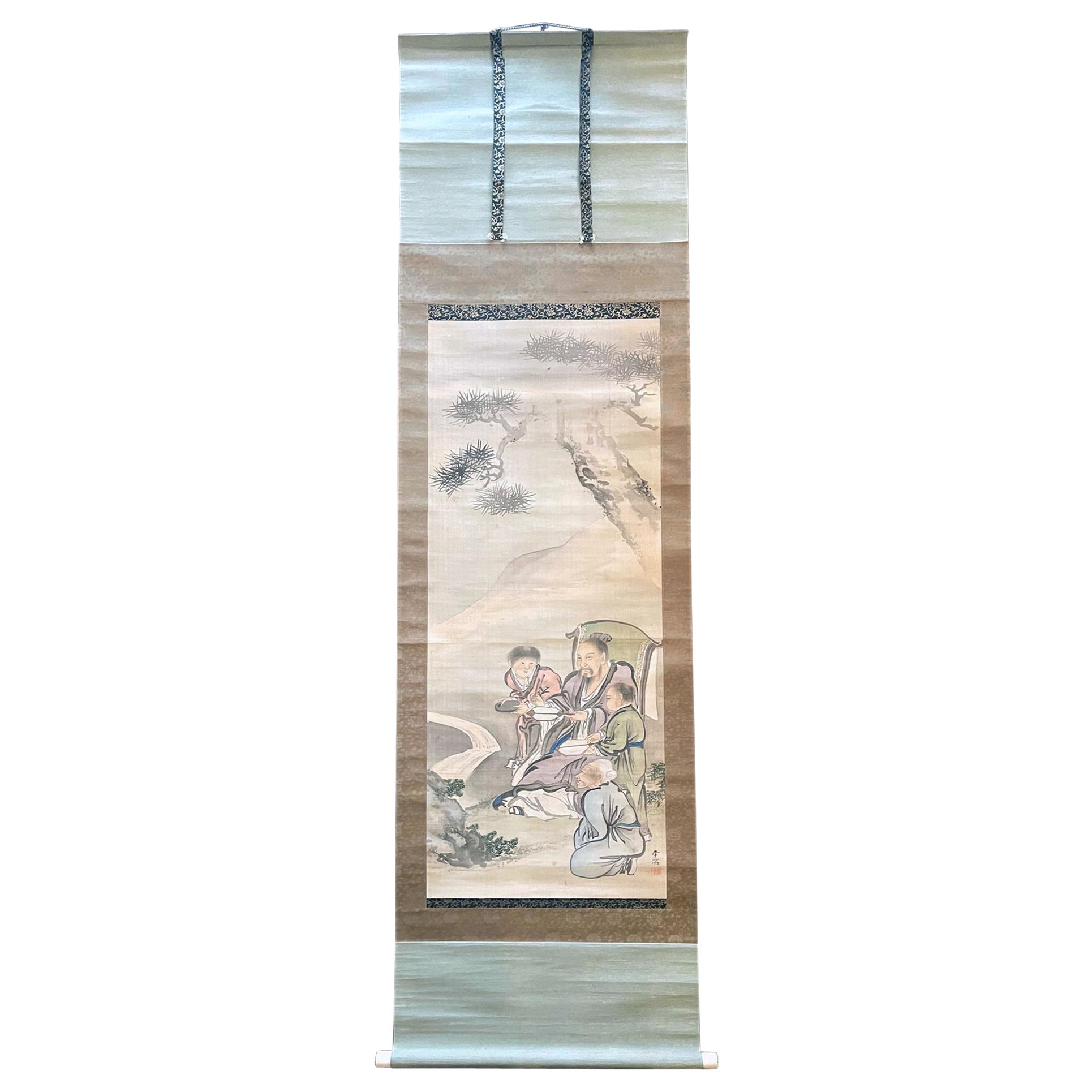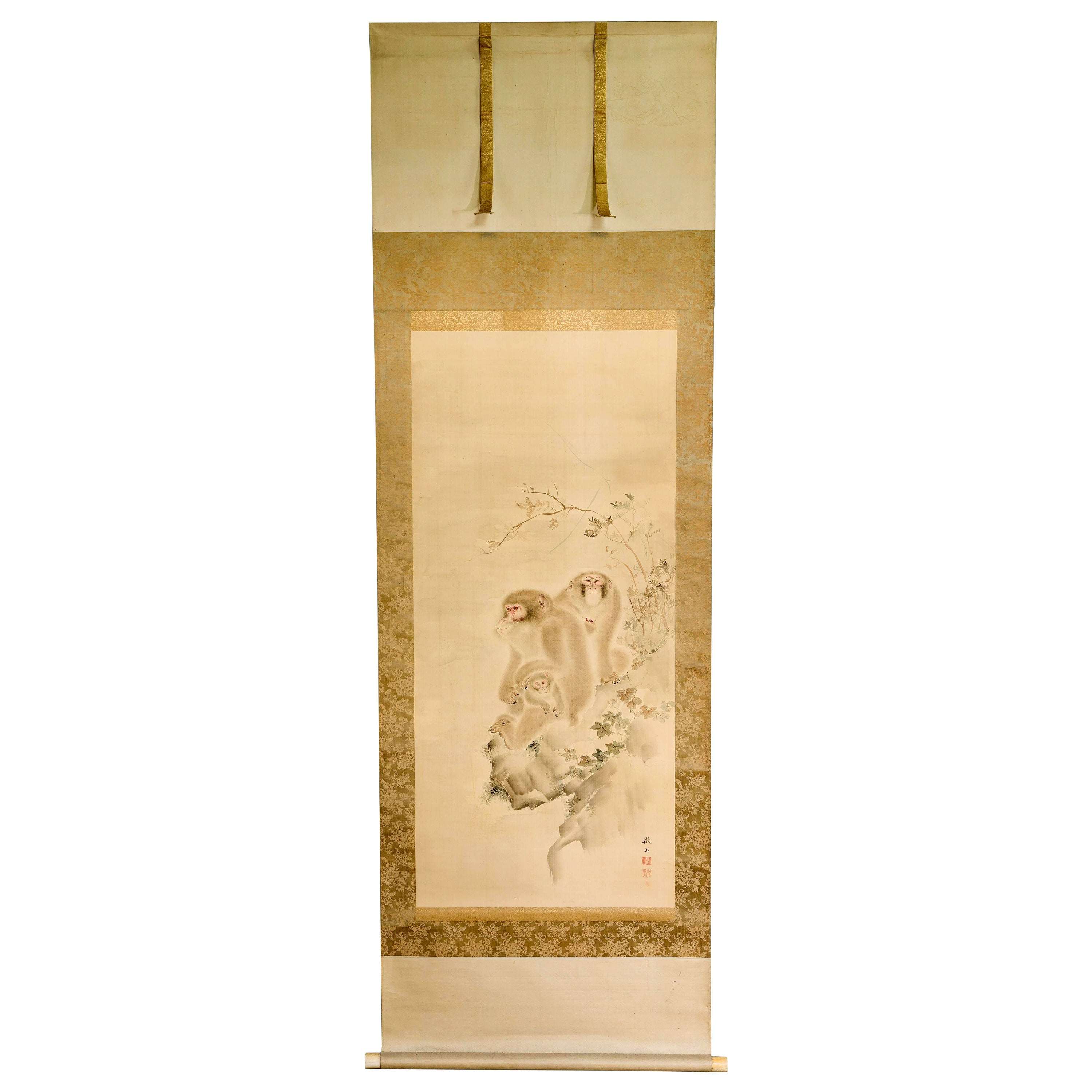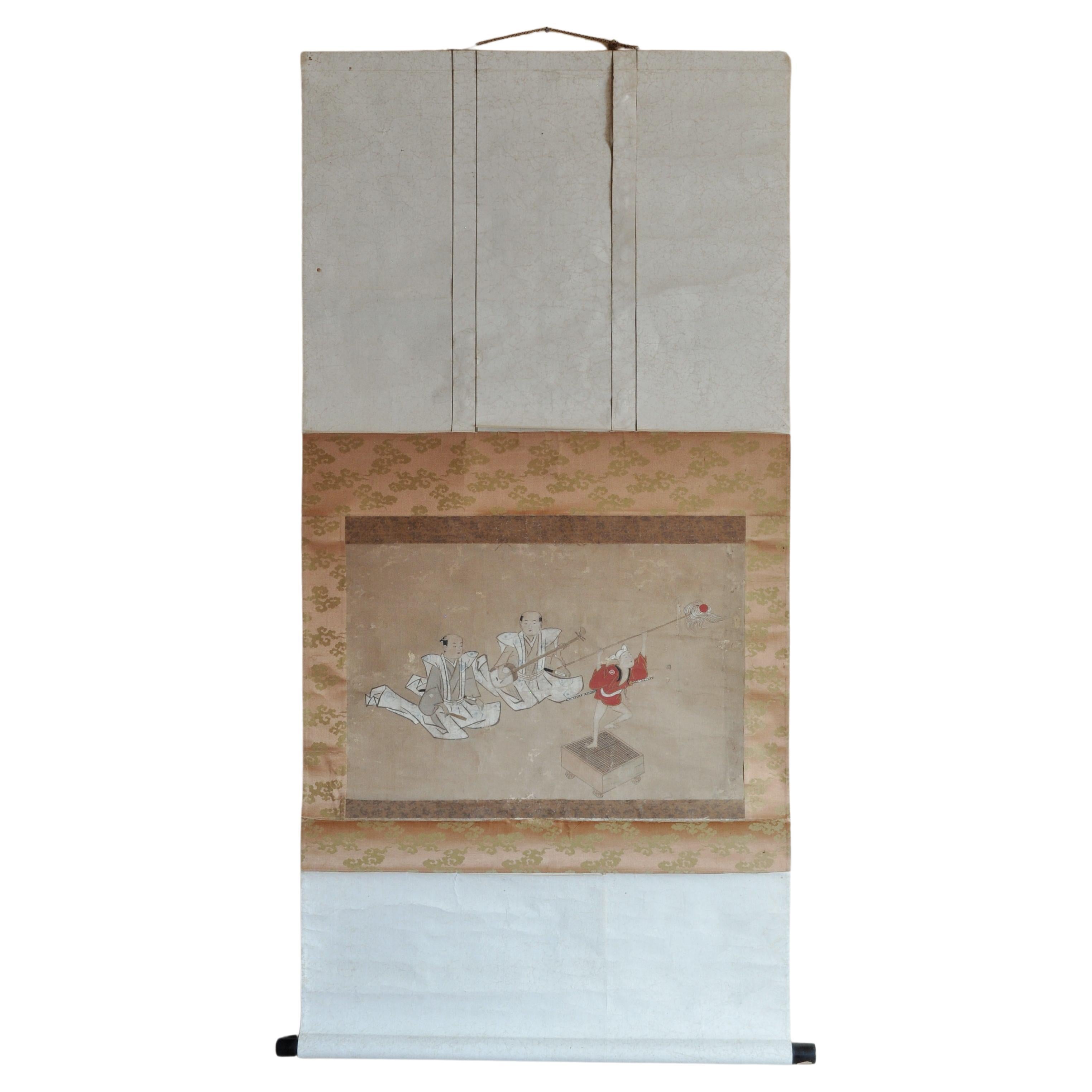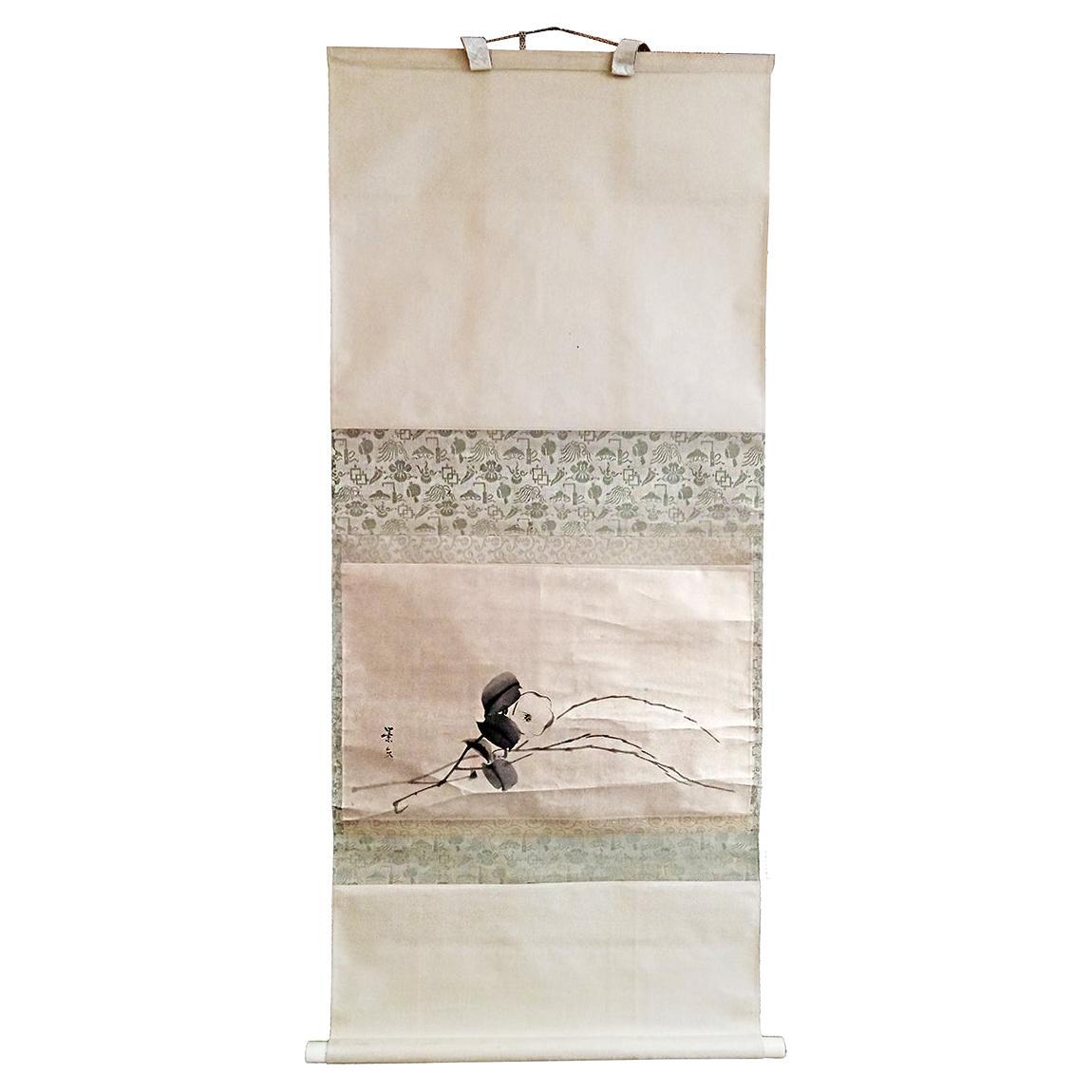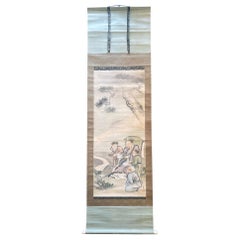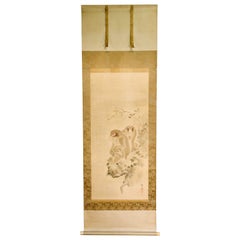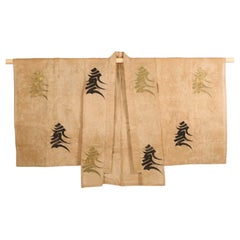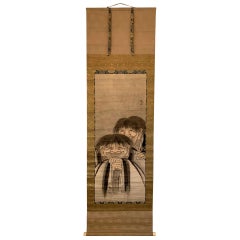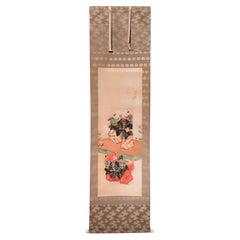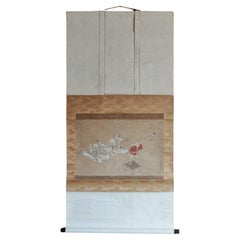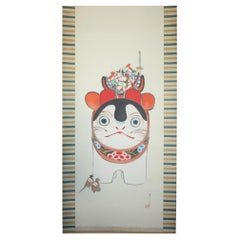Items Similar to Japanese Silk Scroll of Daruma Hanabusa Itcho Edo Period
Want more images or videos?
Request additional images or videos from the seller
1 of 12
Japanese Silk Scroll of Daruma Hanabusa Itcho Edo Period
$2,800
£2,106.74
€2,433.95
CA$3,957.13
A$4,296.67
CHF 2,275.40
MX$52,664.93
NOK 28,159.02
SEK 26,608.78
DKK 18,166.02
About the Item
A Japanese hanging scroll attributed to Edo period painter Hanabusa Itcho (1652-1724). The artwork features a silk roundel nicely mounted in golden brocade background. The painting depicts a robed Daruma seated in meditation with his eyes widely open. The rendition of the famous monk, one of the most beloved subjects in Japanese art, was extremely minimalistic. With just a few effective ink strokes and patches of watercolor, it managed to successfully highlight the essence and spirit of Daruma. The roundel was possibly a center fragment of a larger painting by the artist and was remounted historically. Signed with one of his artist's names. It comes with a wood scroll box with ink inscription of title and artist formal name.
For a painting with the same signature, see number 1881,1210,0.1719 in the collection of the British Musuem. Also a horizontal scroll item number Dongwon 3066 in the collection of National Musuem of Korea.
Hanabusa Itcho was a Japanese painter, calligrapher, and haiku poet of Edo period. He originally trained in the Kano style, under Kano Yasunobu, but ultimately rejected that style and became a literati (bunjin) and formed his own style, which would come to be known as the Hanabusa school. He was also known as Hishikawa Wao and by a number of other art-names.
- Dimensions:Height: 47 in (119.38 cm)Width: 19.5 in (49.53 cm)Depth: 1 in (2.54 cm)
- Style:Edo (Of the Period)
- Materials and Techniques:
- Place of Origin:
- Period:
- Date of Manufacture:18th Century
- Condition:Wear consistent with age and use. Minor surface wear on the silk painting and mount. Wood storage box is worn as shown.
- Seller Location:Atlanta, GA
- Reference Number:1stDibs: LU945034143622
About the Seller
4.9
Platinum Seller
Premium sellers with a 4.7+ rating and 24-hour response times
Established in 2006
1stDibs seller since 2010
568 sales on 1stDibs
Typical response time: <1 hour
- ShippingRetrieving quote...Shipping from: Atlanta, GA
- Return Policy
Authenticity Guarantee
In the unlikely event there’s an issue with an item’s authenticity, contact us within 1 year for a full refund. DetailsMoney-Back Guarantee
If your item is not as described, is damaged in transit, or does not arrive, contact us within 7 days for a full refund. Details24-Hour Cancellation
You have a 24-hour grace period in which to reconsider your purchase, with no questions asked.Vetted Professional Sellers
Our world-class sellers must adhere to strict standards for service and quality, maintaining the integrity of our listings.Price-Match Guarantee
If you find that a seller listed the same item for a lower price elsewhere, we’ll match it.Trusted Global Delivery
Our best-in-class carrier network provides specialized shipping options worldwide, including custom delivery.More From This Seller
View AllJapanese Silk Scroll by Haruki Nanmei Edo Period
Located in Atlanta, GA
A Japanese hanging silk scroll by late Edo period painter Haruki Nanmei (1795-1878). The gouache painting was in the tradition of Kano school and depicts an old scholar dressed in lo...
Category
Antique 19th Century Japanese Edo Paintings and Screens
Materials
Silk, Paper
Japanese Silk Scroll Painting of Moneys Edo Period Mori Tetsuzan
Located in Atlanta, GA
A Japanese mounted vertical hanging scroll painting by Mori Tetsuzan (Japanese, 1775-1841) circa 19th century Edo period. The watercolor and ink on silk ...
Category
Antique 19th Century Japanese Japonisme Paintings and Screens
Materials
Silk, Paper
Antique Japanese Noh Outer Cloak Chōken with Stencil Decoration
Located in Atlanta, GA
A large and striking Japanese outer cloak for Noh performance (known as Choken) circa 19th century (late Edo to early Meiji period). The robe was woven from a natural bast-fiber (kno...
Category
Antique 19th Century Japanese Edo Textiles
Materials
Natural Fiber
Large Antique Zen Japanese Ink Scroll After Sesson Shukei
Located in Atlanta, GA
A Japanese Sumi ink painting with light color wash mounted with brocade borders as a hanging scroll (Kakejiku). The painting depicts the famously eccentric Buddhist monks Hanshan and Shide (known in Japan as Kanzan and Jittoku). Often as a pair, they have been a popular motif in Japanese Zen painting...
Category
Antique 18th Century Japanese Japonisme Paintings and Screens
Materials
Silk, Paper
Japanese Gohonzon Buddhist Calligraphy Mandala Scroll Meiji Period
Located in Atlanta, GA
A Japanese sumi ink calligraphy Buddhist mandala mounted as a paper hanging scroll known as Kakejiku or sometimes Moji mandala. Termed as gohonzon in Japanese, it is a venerated object within Nichiren Buddhism (Hokkeshu; lotus sect). The originally concept was developed by the 13th century Buddhist priest Nichiren to guide the energy of the devotional chanting to...
Category
Antique 1890s Japanese Meiji Paintings and Screens
Materials
Paper
Japanese Silk Suijaku Scroll Nyorai-Kojin with Mixed Buddhism and Shinto Deities
Located in Atlanta, GA
A Japanese silk Suijaku hanging scroll beautifully presented in a custom wood shadow box frame from Edo period (circa 18-19th century). The scroll, surmounted on golden brocade was painted in fine details with gouache, ink and gold powder highlight, served as a Suijaku mandala for the worshippers. Honji Suijaku is a complicated religious concept uniquely developed in Japan. It mixed and hybrid the Buddism deities with native shinto spirits (known as Kami), which were seen as local manifestations (the suijaku, literally means a "trace") of Buddhist deities (the honji literally the original ground). The original idea may lie with the synergetic strategy to spread Buddism by making it more relatable to the local population who had already worshiped Shinto gods. The paradigm, adopted in the 10th century from an orignal Chinese concept, remained a defining feature of Japanese religious life up to the end of the Edo period (1868). Instead of being confined to deities, its application was often extended to historical figures as shown on this scroll.
This long hanging scroll depicts an arrangement of 21 figures including Buddhism and Shinto deities as well as two historical figures on the bottom. Each figure was name-tagged in Kanji for easy identification by the worshippers. It was used in the temple or shrine so that when the worshipper prayed in front the mandala, they prayed simultaneously to all the deities.
On the very top, sits Nyorai-Kojin, a hybrid deity of Nyorai Buddha and Kojin, the kaki for fire, stove and kitchen. From the top to bottom and left to right, here is the list of the deities: Kanon with Thousand Hands, Kanon with Willow Branch, Monju Bosatsu...
Category
Antique Early 19th Century Japanese Edo Paintings and Screens
Materials
Silk, Wood
You May Also Like
Japanese Noh/Kabuki Shakkyo painting, Torii Kiyotada
Located in Point Richmond, CA
Japanese colors, gofun and metallics on silk painting of Noh/Kabuki Dancers, depicting two figures of actors dancing in the play Shakkyo portraying a pair of shishi (lions), one on a...
Category
Early 20th Century Japanese Meiji Paintings and Screens
Materials
Silk
19th century Edo period's Hanging scroll Samurai players and child dancer
Located in Chiba, JP
Description - Hanging scroll with quite a surreal scene of the music and dance performance with two seated samurais and a child actor on a go-game-board who plays a role of dancing s...
Category
Antique Mid-19th Century Japanese Japonisme Paintings and Screens
Materials
Paper
Japanese Antiques 4th Head Torii Kiyotada Silk color scroll Momotaro Ukiyo-e
Located in Niiza, JP
Torii School 7th Head [4th Head Torii Kiyotada] Silk color scroll Japan No. 1 Momotaro Ukiyo-e
Silk color
Scroll head: Wood
box: Paulownia wood
Image size: 410 (W) x 1150 (H) [mm]
S...
Category
Antique 19th Century Japanese Paintings and Screens
Materials
Silk, Paper
Silk Scroll Painting by Matsumura Keibun, 18th Century
By Matsumura Keibun
Located in New York, NY
A silk parchment scroll with a Camellia Flower painting, by Japanese artist Matsumura Keibun (1779-1843).
The younger half-brother to Matsumura Goshun, founder of the Shijo schoo...
Category
Antique 1790s Asian Edo Paintings and Screens
Materials
Silk, Parchment Paper
Antique Japanese 17th c Edo Scroll Kano Yosanobu Buddhist Painting
Located in Amsterdam, Noord Holland
Eishin Kano's Ebisu/Great Country Map, double-width/comes with an old box.
The auspicious statues of Ebisu and Daikoku are standing in a double-width hanging scroll with a smiling fa...
Category
Antique 18th Century Edo Paintings
Materials
Silk
$3,445 Sale Price
20% Off
Japanese PAinting Taisho Period Scroll Head and Cane Nihonga Otani Kubutsu
Located in Amsterdam, Noord Holland
[Otani Kubutsu]
1875-1943, a monk of the Otani school of the Shinshu sect (23rd head of Higashi Honganji Temple) during the Meiji-Showa period.
Dharma name: Shonyo. Literary name: Kō...
Category
Vintage 1930s Taisho Paintings
Materials
Silk
$1,242 Sale Price
20% Off
More Ways To Browse
18th Century Japanese Screens
Scroll Boxes
Edo Period Japanese Painting
Japanese Edo Period Screens
18th Century Japanese Silk Painting
Japanese Paper Scroll
Large Antique Fragment
Edo Scroll
Japanese Hanging Scroll
Ink Scroll
Meditation Seat
Edo Period Scroll
Japanese Daruma
Japanese Lacquer Panels
Chinese Carved Screen
Kano School
Byobu Screens
Asian Black Screens
